Hello again, and welcome!
We are now just over two weeks away from Election Day, when Massachusetts voters will be asked to vote on a ballot question that could potentially legalize physician assisted suicide in our state. Continuing my series of reflections on this issue, this week I want to offer several points you can share with your families and friends on why this ballot initiative is wrong for Massachusetts.
Ten reasons to oppose Question 2
There are many groups opposing the legalization of assisted suicide in the Commonwealth of Massachusetts and that are urging a "No on Question 2" vote this Nov. 6. In total, more than 100 reasons to oppose this ballot measure have been shared with me since we began our educational efforts on this issue. Some arguments are based on principle, others on prudence, and still others on process — and all of them are valid. Today, I want to share with you ten of the most compelling. In turn, I encourage you to share these reasons with all those you know between now and Election Day.
(1) Question 2 would legalize assisted suicide; suicide is always a tragedy and never a dignified way to die. For many people, opposition to assisted suicide is based on respect for God’s law, "Thou shalt not kill." However, one does not need to be a person of faith to understand the tragedy of suicide. Our society admires suicide prevention organizations like the Samaritans that stand ready to help people in the throes of depression and suicidal thoughts. Their hotlines are staffed with volunteers, always prepared to try to bring solace and help to those suffering from suicidal impulses. There are also heroic first responders who often risk their lives to help stop someone from taking one’s own life. Yet, proponents of Question 2 are trying to convince us that assisted suicide at the end of life is not suicide — they strive to avoid the word suicide — and rather a compassionate response to the plight of people who have a terminal illness. It is not. Do not be misled by the seductive language of "dignity," "mercy," "compassion" or "aid in dying." True compassion does not put a lethal weapon, in this case a prescription of 100 capsules of Seconal, into the hands of a person to help take his or her life.
(2) Suicide always impacts others beyond the individual that takes his or her life. Proponents of Question 2 assert that "dignity" requires a radical form of autonomy and control in which one should be able to determine the manner and time of one’s death. They ignore the profound interconnectedness of our lives and the impact suicide has on family members, colleagues and society in general. Suicide researchers describe the "copycat syndrome" where the publicity of one suicide in a community leads others to contemplate or act on it. Suicide prevention organizations worry that suicides in the general population will increase if society legalizes assisted suicide because it creates the message that suicide is an acceptable and legal "choice" in some situations. As a society, we shouldn’t sanction suicide as a response to hardship.
(3) Doctors strongly oppose assisted suicide and Question 2. Organizations of physicians, including the Massachusetts Medical Society (MMS) and American Medical Association (AMA), have argued that assisted suicide would bring about a massive change in the nature of medical care and the doctor-patient relationship. Not only will it violate the values and oaths of the medical profession, but it will destroy trust between patients and doctors because some patients will see doctors and nurses as possible executioners, rather than as defenders of life. Doctors worry that cost-containment pressures in health care will make a prescription for assisted suicide seem attractive for certain conditions. They fear being coerced to write prescriptions or to make referrals to "specialists" who barely know the patient but will write an assisted-suicide prescription. They are also concerned that there is no requirement that the doctors who write the prescription will have particular training in terminal diseases or end-of-life care. Doctors from these organizations believe that the discussion should be about how we can improve care at the end of our lives, not to improve "options" to help patients end their lives.
(4) Advocates for the disabled strongly oppose assisted suicide and Question 2. They point to the lack of adequate safeguards, which could open the door to abuse, manipulation and coercion. They state that the lack of safeguards could lead to increased elder abuse, because it allows a witness to the patient’s signed request for assisted suicide to be an heir, beneficiary or possibly exploitative caretaker. Question 2 even allows proxy requests that allow someone familiar with the mode of communication of a terminally-ill person to indicate that they are requesting suicide. Advocates for the disabled are concerned that Question 2 may eventually lead to "quality of life" standards in our society where those with a lower perceived quality of life receive fewer benefits or protections, or to situations like the Netherlands where there is "non-voluntary" and involuntary euthanasia. In short, they believe that assisted suicide will make the vulnerable more vulnerable.
(5) Terminal diagnoses are often wrong. Under Question 2, eligibility for assisted suicide is based on a terminal diagnosis of six-months or less. There is no specificity whether this six-month diagnosis is with or without medical treatment for the illness. Doctors know terminal diagnoses are simply their best estimate and that these predictions are often inaccurate. Patients often live months, even years, longer. Question 2 could lead people to make a life or death decision based on someone’s guess, give up on treatment and lose good years of their lives.
(6) Question 2 is shockingly flawed. Even voters that might generally be in favor of assisted suicide have been shocked by some of the elements of Question 2 and have committed to vote no. Most people first think that "physician assisted suicide" consists of receiving one pill from their family physician to be ingested in the presence of a doctor. They are shocked to learn that, instead, a specialist (who likely doesn’t know the person and who isn’t required to have pain-management training) would provide a prescription for 100 pills to be dispensed at a neighborhood pharmacy and then ingested all at once with no doctor present. They are also shocked to learn that there is no oversight of the lethal drug once it is dispensed to the patient and that there need not be witnesses to the act of suicide to prevent abuse. They are astonished to learn that the death certificate won’t indicate that they patient died of assisted suicide and that there are no enforcement provisions, investigative authority, oversight or data verification included in Question 2.
(7) Question 2 does not require a patient to consult with a psychiatrist or palliative care expert before receiving the lethal prescription. Many terminally ill patients suffer from depression and there is no requirement that a psychiatrist determine that the person is of sound mind before the request is granted. Additionally, there is no requirement that the doctors who are consulted have expertise in palliative care to ensure that a fear or experience of pain, which can be managed, is leading to the request. Many attendees of our educational workshops have been surprised that these reasonable safeguards aren’t included.
(8) Question 2 does not require family notification. There is no requirement that the patient notify family members. For example, a husband could receive a lethal prescription without his wife being required to be notified. A mother could feel a "duty" to not be a burden and to leave a large estate to her children without her children having a chance to state that they care more about her than her money. Out-of-state family members might not know that their loved one is contemplating suicide and have an opportunity to intervene. Compassionate care at the end of life should involve the loving support and involvement of family members.
(9) Assisted suicide would weaken efforts to expand and improve palliative care. Palliative and hospice care, and the loving support of family members, are better alternatives than suicide for the terminally ill. Palliative care is a person-centered approach that treats all of the different aspects of pain and suffering. Palliative care experts consider assisted suicide as a "lazy way out." Rather than ending a life that is filled with pain and suffering, we should offer compassion, respect and dignity by providing the best in palliative care. That is where our efforts should be directed. However, the incentive to do so will be removed if assisted suicide becomes legal, because suicide will become a substitute for quality health care in some situations. It is also likely, palliative care leaders say, that investment in training for palliative care, effective pain management, and end-of-life communication will be undermined.
(10) Complex issues like assisted suicide should be decided in a legislative process rather than a ballot initiative. Some voters in Massachusetts oppose Question 2 because they believe that a ballot initiative process (dominated by 30-second commercials and sound bites) is not a good way to deal with a complex, ethical issue involving life and death. The legislature exists to review proposals, hold public hearings and build consensus on complicated issues.
When we grow old or sick and we are tempted to lose heart, we should be surrounded by people who ask "How can I help you?" We deserve to grow old in a society that views our cares and needs with a compassion grounded in respect, offering genuine support in our final days. The choices we make together now will decide whether this is the kind of caring society we will leave to future generations. Please join me on Election Day to stop assisted suicide by voting "No on Question 2."
– – –
Also, the Committee Against Physician Assisted Suicide recently began airing television and radio commercials to educate the public on Question 2. They are excellent and I encourage you to view them and share the link with others:
– – –
Last week I mentioned that I celebrated a special Mass to open the Year of Faith, which began on October 11. I want to share the video of the homily with you this week.
– – –
Thursday I was happy to host a Mass and reception to thank our parish Catholic Appeal coordinators here at the Pastoral Center.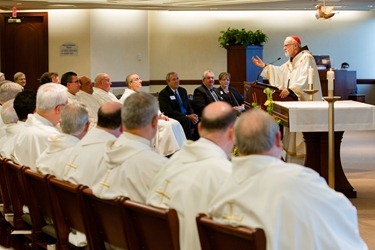
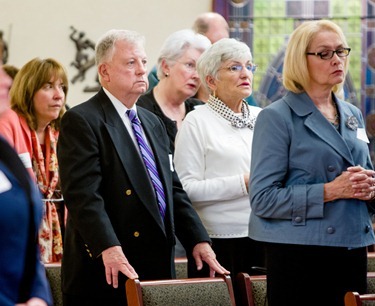
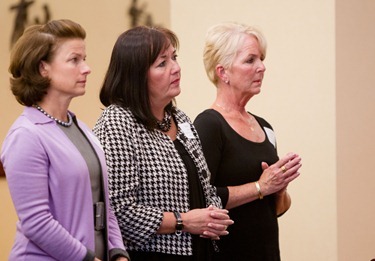
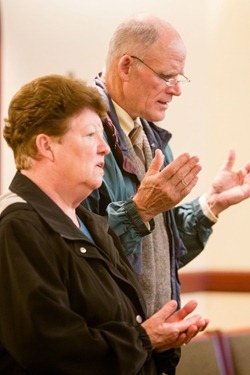
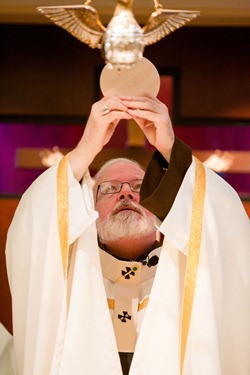
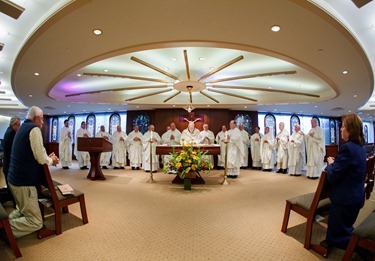
Parishes that have appeal coordinators are much more likely to achieve their goals, which is a great help for the parish as well as the development efforts of the archdiocese. 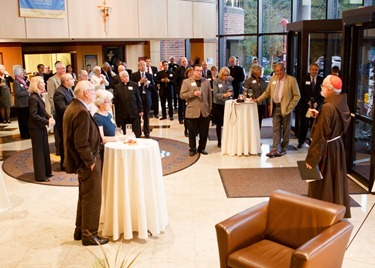
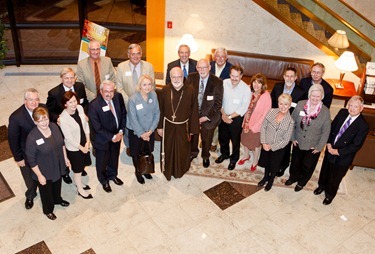
So, of course, we are very grateful to those who give their time and devote their energy to help raising the monies to support the mission of the Church.
Earlier in the week, about 40 volunteers also helped out for a phone-a-thon to contact people who have given to the appeal in the past but have not contributed yet this year.

I am so grateful for all their efforts.
– – –
On Friday I visited the Betania Spiritual Life & Marian Center in Medway. It was my first time visiting their new facility there. It is very beautiful. 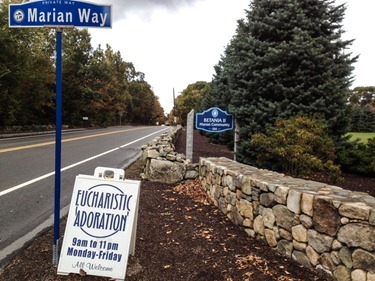
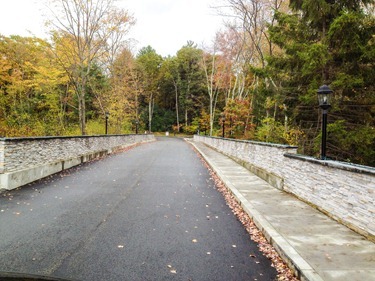
We had lunch there with Rose Patek who has been very supportive of the center and very helpful with the work of campus ministry and evangelization in the Archdiocese. 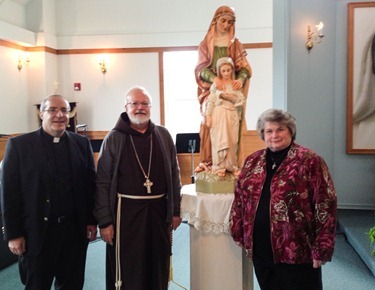
Rose led us on a tour of the facilities, including the greatly enhanced Marian Center and the newly constructed dormitory building that can accommodate over 100 people for retreats.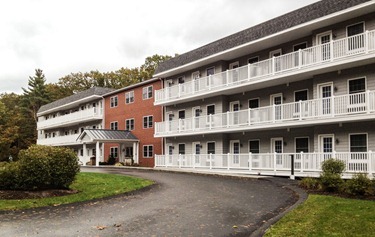
The Center has more than 100 acres of wooded land. On the grounds they have a number of statues including St. Michael the Archangel and St. Francis.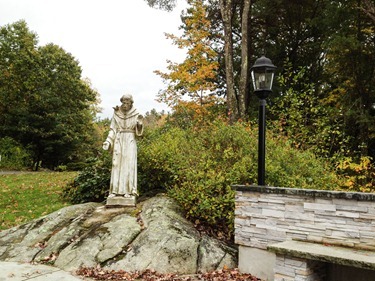
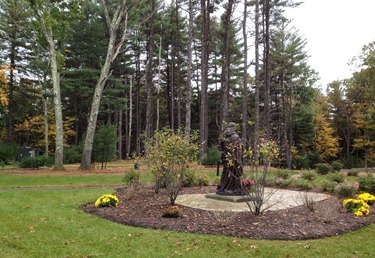
It is a very beautiful facility and is a powerful center of spirituality and a great grace for the Archdiocese to have them here.
– – –
That evening, I attended the Massachusetts Family Institute’s Fundraising Banquet. The organization, headed up by Kris Mineau, works to promote family values for the good of all people in our society. Among their current priorities is the campaign against physician assisted suicide.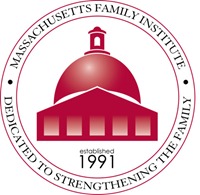
Each year, the banquet features a prominent pro-family speaker. This year, we heard from former US Secretary of Education Bill Bennett. He gave a very inspiring talk.
Among those recognized at the dinner was Mary Roque, an elder law attorney from Medfield, who produced a video on physician assisted suicide.
– – –
Saturday I visited the Franco-American School in Lowell to celebrate the 100th anniversary of the grotto of Our Lady of Lourdes and the Stations of the Cross at the school. The Franco-American School is run by the Sisters of Charity of Québec and Sister Lorraine Richard is the principal there.

The grotto and stations had been recently refurbished and are very, very beautiful. 
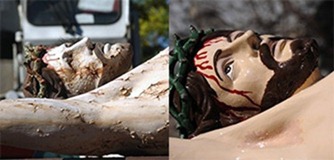
A before and after view of some of the restorations
They had been dedicated exactly 100 years ago to the day of our visit.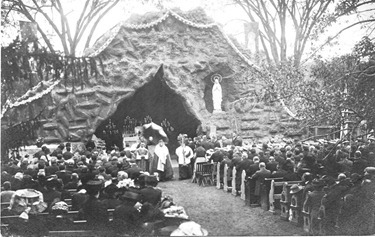
I was pleased to see such a large crowd for an outside Mass on a very brisk October day.


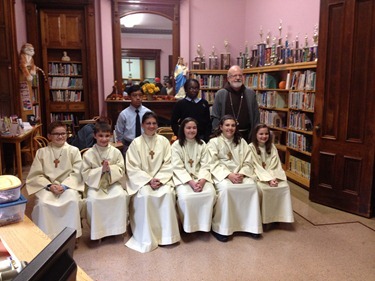
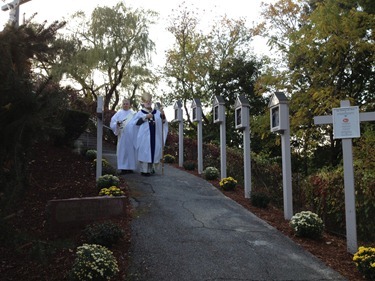
– – –
Then, in the evening, I attended the fundraising dinner at Florian Hall in Dorchester to support the Irish Pastoral Center. 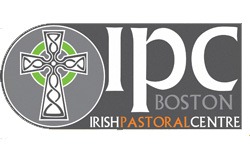
This year, the Center honored Father Dan Finn, Pastor of St. Mark and St. Ambrose parishes in Dorchester, who was very instrumental in the foundation of the Center and has worked with them for many years.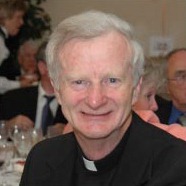
He gave a wonderful talk and has a great memory for reciting lyrics. He began with Father Faber’s “The Faith of our Fathers” and then he went into Joseph Mary Plunkett’s famous poem “I see his blood upon the rose.” He ended up singing Irish ballads, to the delight of the all the people there.
I was also pleased to be able to spend time with Irish Consul General Michael Lonergan, as well.
– – –
On Sunday, I went to Millis to celebrate the 75th anniversary Mass of St. Thomas Parish. The church is in magnificent condition. 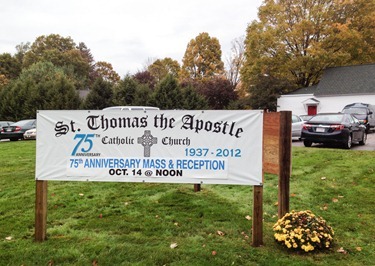
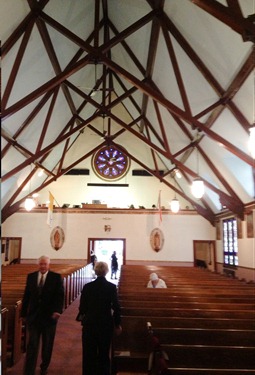
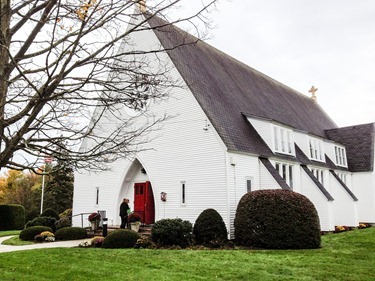
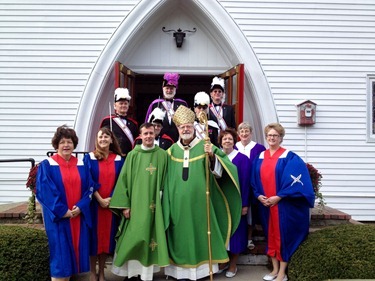
Father Brian Kiely, pastor of St. Patrick Parish in Natick, who had been administrator at St. Thomas recently, was there along with the present administrator, Father David Goodrow.
The readings of the Mass included the story of the rich young man, which gave me the opportunity to share with the people that when Jesus was asked “What must we do to be saved?”, the first thing he told the young man is “thou shalt not kill.”
I related that to our present circumstance, in which we are confronted with this physician assisted suicide ballot initiative that would be a violation of the very first thing that Jesus tells us we must do if we want to be saved. I challenged the people, as Christ’s disciples, to be courageous and listen to our faith in defending the most vulnerable in our society by defeating this legislation which is so dangerous and so rife for the possibility of abuse.
– – –
From St. Thomas I went to the wake of Father David Doucet. I had visited him just a couple weeks ago. In final days of his life he had been living with his niece and her family.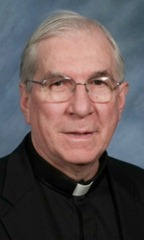
I was happy to be able to attend the wake, say a prayer for him, and personally extend our condolences to the family.
– – –
Sunday evening was the annual St. James Society Cardinal Cushing Awards Dinner.
Cardinal Cushing founded the St. James Society just over 50 years ago. Pope John XXIII had asked religious and priests from Canada and the United States to help the Church in Latin America. One of the responses to that invitation was the St. James Society. Since that time, over 300 priests have served in the Society. Not only has it been a great benefit for the Church in Peru, Ecuador and Bolivia but also for the Archdiocese, because for many decades those priests who returned from the missions then worked with our own Hispanic population in the archdiocese.
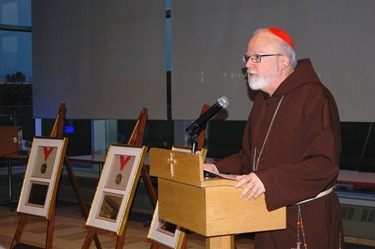
This year, they honored three people with long-standing relationships to the St. James society: Father Peter Quinn, Dr. Martin Dunn and Sister Carlotta Gilarde. 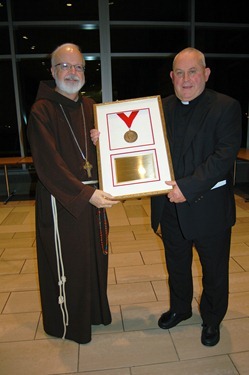
Father Peter Quinn for decades has run an annual golf tournament as a benefit for the St. James Society
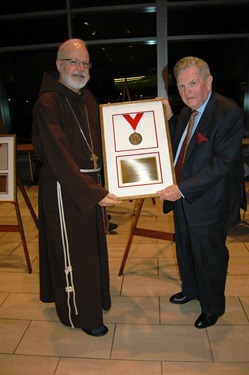
Dr. Martin Dunn has made more than 50 medical trips down to the missions
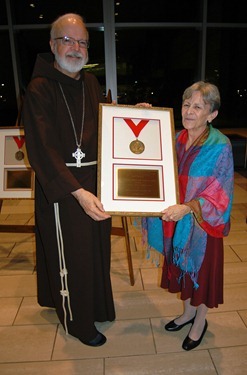
Sister Carlotta Gilarde was one of the early pioneers of the Society and spent many years assisting their mission in South America
All three honorees gave inspiring testimonies as they were presented with the Cardinal Cushing Award.
There were three tables of sisters of St. Joseph at the event, in support of Sr. Carlotta. It was good to see them, we are all grateful for their presence and that of all our communities of religious sisters in the Archdiocese. During the evening they showed a film of the wonderful work that the society of St. James is doing. It was a lovely event.
– – –
On Monday I met with representatives of Cuan Mhuire during their visit to Boston. Archbishop of Dublin Diarmuid Martin asked me to meet with this wonderful group that is doing such extraordinary work in Ireland with the residential care that they give people suffering from addictions.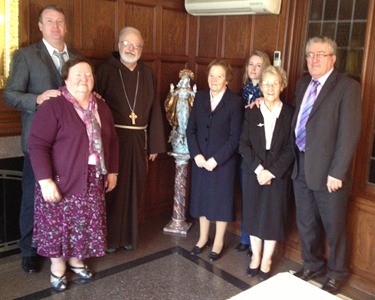
Sister Concslio Fitzgerald, S.M., Founder and Guardian of Cuan Mhuire, Prof. Raymond Kinsella, Justin McCarthy and Orla O’Shea came to share information on their mission.
They have been very, very successful in helping people out of the horrors of a life of addiction. Their strong spirituality and Marian devotion has been important ingredient success of the programs.
– – –
Later that day, John and Claire Bertucci, who are friends, supporters of the Archdiocese, and members of the board of the Isabella Stewart Gardner Museum, invited me to see the museum’s new addition. 
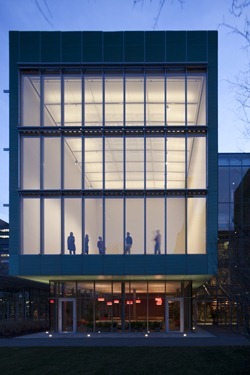
It is an extraordinary edifice.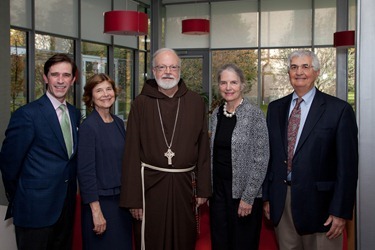
With Damien DeVasto of our staff, museum director Anne Hawley, Claire and John Bertucci
Museum director Anne Hawley gave us a tour of the exhibits and the new space including a wonderful new musical venue that is a perfect cube. 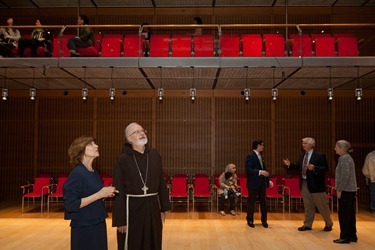
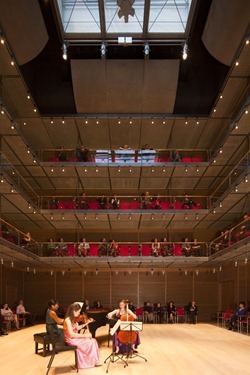
The acoustics are just extraordinary.
We also paid a visit to the Claire and John Bertucci Education Room, which serves as a centerpiece of the educational programs that the museum runs for thousands of local children.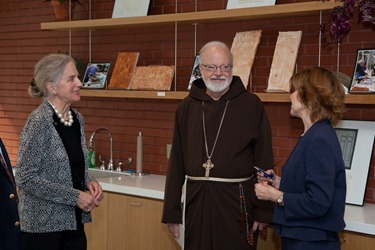
Studies show that children who are exposed to the arts perform better academically.
Of course, they also have many beautiful works of religious art including many valuable masterpieces.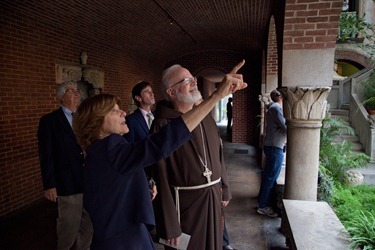
Anne is pointing out the Capuchin crest, which I pointed out to her in my first visit to the museum!
The Gardner Museum is a wonderful part of the cultural landscape of Boston. I was very gratified to see how many visitors were in the museum, even on a weekday.
– – –
In the evening, I went to Merrimack College to attend the ceremony for their Center for the Study of Jewish-Christian-Muslim Relations annual Goldziher Prize. The award was presented to Rabbi Burton Visotzky for his work in building Jewish-Muslim relations.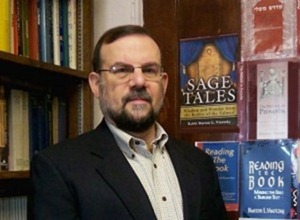
Rabbi Visotzky spoke about the fact that there are many who feel he is wasting his time but he was very gratified that the Catholic Church is appreciative of what he is trying to accomplish.
Dr. Mohamed Lazzouni, Chair of the Advisory Board of the Center, gave an opening talk and we were welcomed by Merrimack President Christopher Hopey.
A number of the Augustinian friars were also present, including Father Bill Gartland, who had been my Superintendent of Schools in Fall River and is now living at Merrimack College.
– – –
Tuesday I went to St. Mary’s High School in Lynn for a Mass of the Holy Spirit to inaugurate the school year and, at that Mass, to inaugurate the new head of school, Grace Cotter Regan.
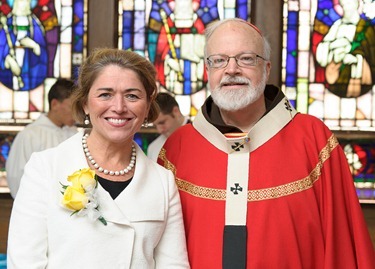
She brings great energy and enthusiasm to this position that I am sure will be wonderful for the school. She is also someone who will strongly support the Catholic identity of the school. The school has recently established four pillars for success: Catholic, Excellence, Integrity and Respect. 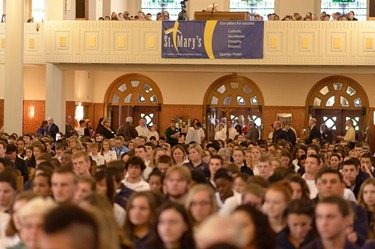
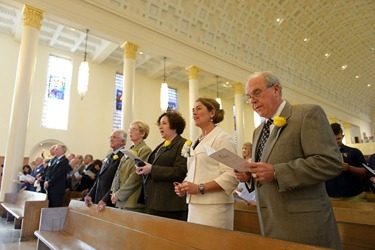
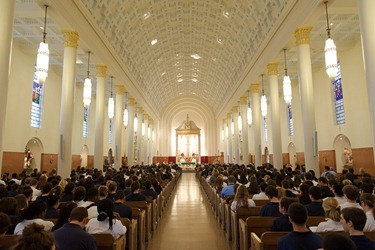
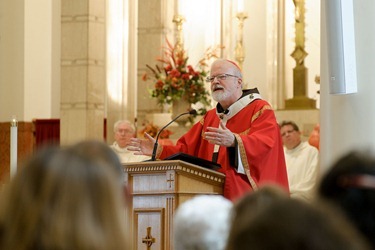
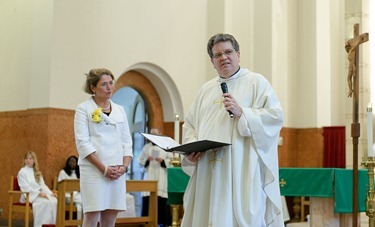
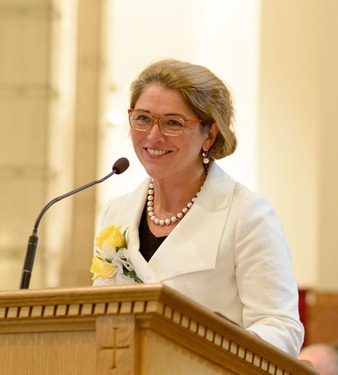
Father Brian Flynn, Father Joe Rossi and Msgr. Paul Garrity were there to concelebrate the Mass with me. One of our seminarians, Gerald Souza, who is serving at the parish during his diaconate year, was there as well.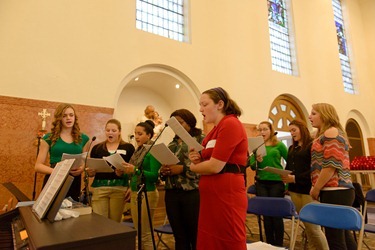
The students did a wonderful job with the music program.
At the end of the Mass they gave Mary and I St. Mary’s School sweatshirts.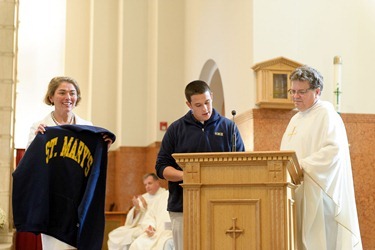
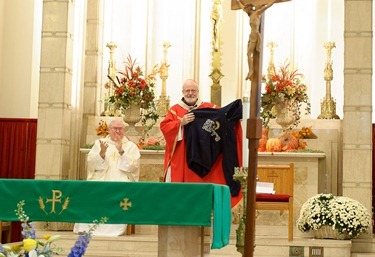
– – –
That evening, I was happy to host one of our regular St. Andrews Dinners. It is an opportunity for high school-aged men who may be considering a vocation to the priesthood to get to know a little about the seminary.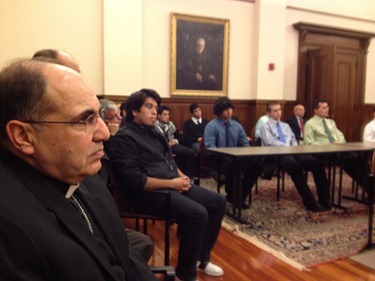
I was very happy that Bishop Peter Uglietto was there along with priests and volunteers from several of our parishes, who accompanied young men from throughout the Archdiocese. Of course, our three Vocations Directors— Father Hennessy, Father Harrington and Father Gabino — were there, as well.
We had a Holy Hour and Vespers followed by dinner with the seminarians.
During the evening, the young men have a chance to hear from some current seminarians. 
Christopher Bae and Michael Zimmerman spoke about their vocation story. Afterward I gave the brief talk and Bishop Uglietto closed the evening with a prayer.
Until next week,
Cardinal Seán
